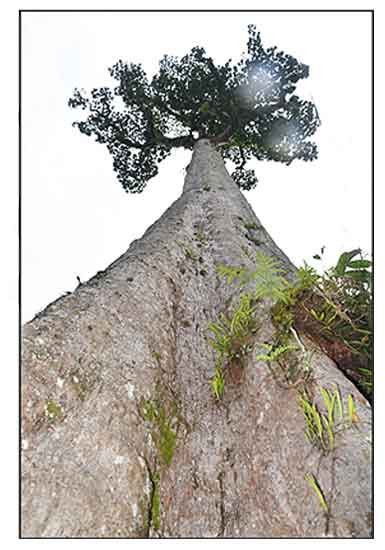 Gen info Gen info
- The genus Petersianthus comprises only 2 species. One is in West Africa, the second, P. quadrialatus is endemic in the Philippines.
- It is one of the largest tree species in the Philippines. The currently known tallest P. quadrialatus is in the Alegria municipality in the northeastern part of Mindanao: 65 meters (213 feet) high, 360 cm (140 in) in diameters, and estimated to be ~ 300 years old.
(7)
- Plywood produced from toog trees are in great demand in foreign markets because of quality, appearance, and exquisite design. Toog is now recognized in the local and world market under the trade name Philippine rosewood. With great demand, depletion threatens. While some consider the tree "alive and well", some consider it a vanishing timber. (2)
- In 2020, it was IUCN Red Listed as "Near Threatened."
(6)
Botany
Toog is a deciduous, medium-sized to fairly large tree that grows up to 40 m tall and 100 (-250) cm in diameter. The trunk is straight, cylindrical, branchless with a length of 20-30 m. Buttress is occasionally up to 2 m high. Bark surface is flaky, fissured, dark brown to grayish red; inner bark is tough, fibrous, and pinkish. Leaves are arranged spirally, simple, alternate. Flowers are in panicles, and have four white petals. Fruit has 4 seeds, in capsule, circular with four papery wings. (2)
 Distribution Distribution
- Native to the Philippines.
-
Common in primary rainforests, near riverbanks or on hillside, in swampy and cool places, from sea level up to 400 m.
- Abounds in Agusan, Surigao, Davao del Norte, Leyte, Samar, Negros and Masbate; also reported to be growing in Laguna, Sorsogon and Bataan.
- Listed as "Near Threatened" by IUCN Red List of Threatened Species in 2020.
(6)
Constituents
- Study of dichloromethane extract of air-dried twigs and leaves yielded stigmasterol (1) and taraxerol (2), while leaves yielded unsaturated triglycerides (3) and a mixture of ß-amyrin fatty acid ester (4a) and α-amyrin fatty acid ester (4b) in a 2:1 ratio. (3)
Parts used
Leaves, twigs.
Uses
Edibility
- Seeds are edible and taste like peanuts.
Folkloric
- Leaves used for treating skin rashes.
Others
- Timber: Wood is hard and difficult to cut. Toog has been found to strong as akle, ipil and molave. Wood is used for manufacture of face veneer and fancy plywood, pulp and paper making. It is suitable for general construction, beams, joists, paneling, mine timber, bridge building, pallets, poles, wood piles for wharves and piers. (2)
- Fuel: Branches, twigs and sawdust can be used for making charcoal briquettes. (2)
Studies
• Antimicrobial / Leaves: In a study for antifungal properties of leaf extracts using spore germination assay against Aspergillus niger, Petersianthus quadrialatus showed moderate inhibitory potential on colony growth (10.97 mm) and spore germination (49.5). (4)
Availability
Wild-crafted.
|

![]()





